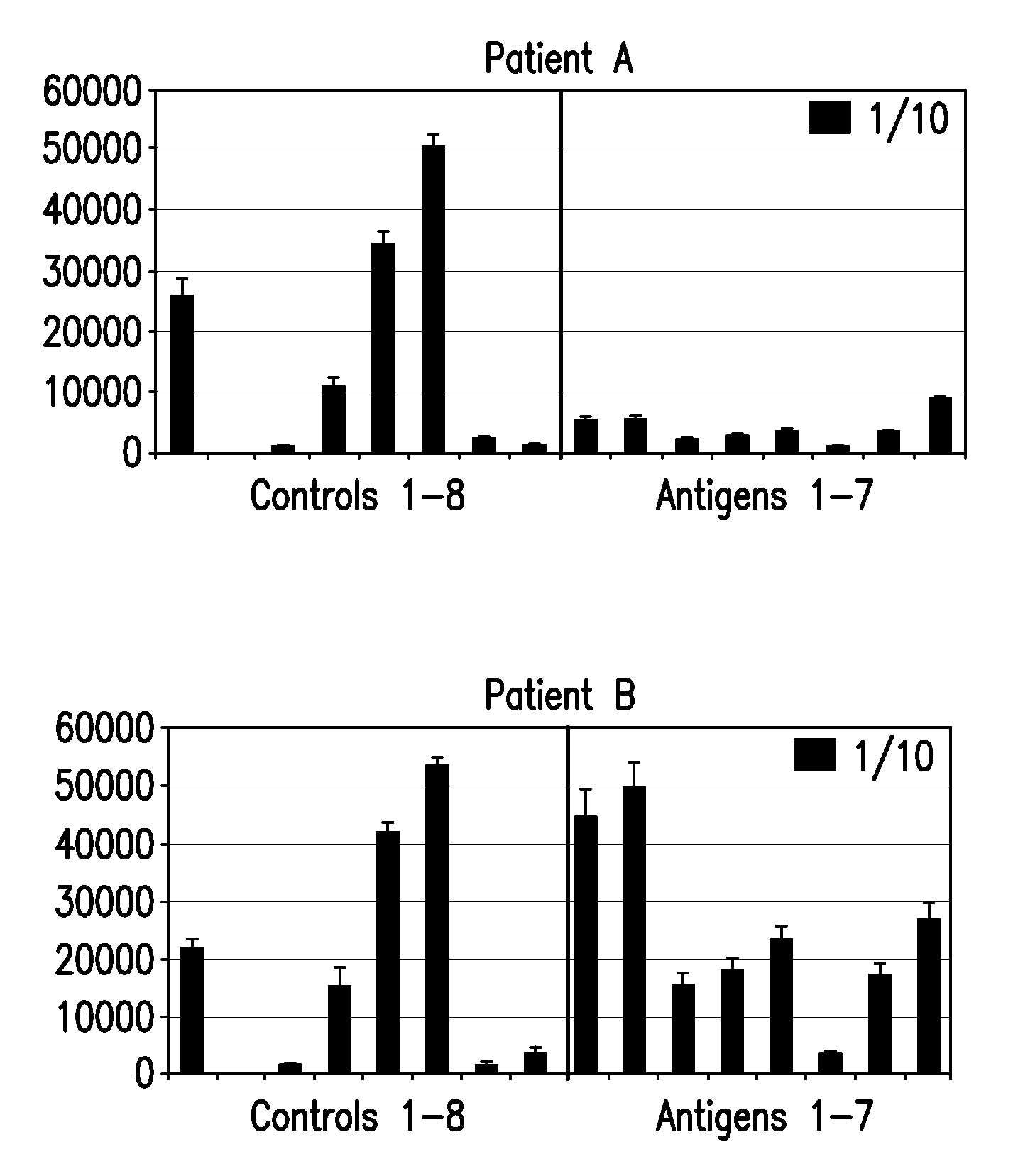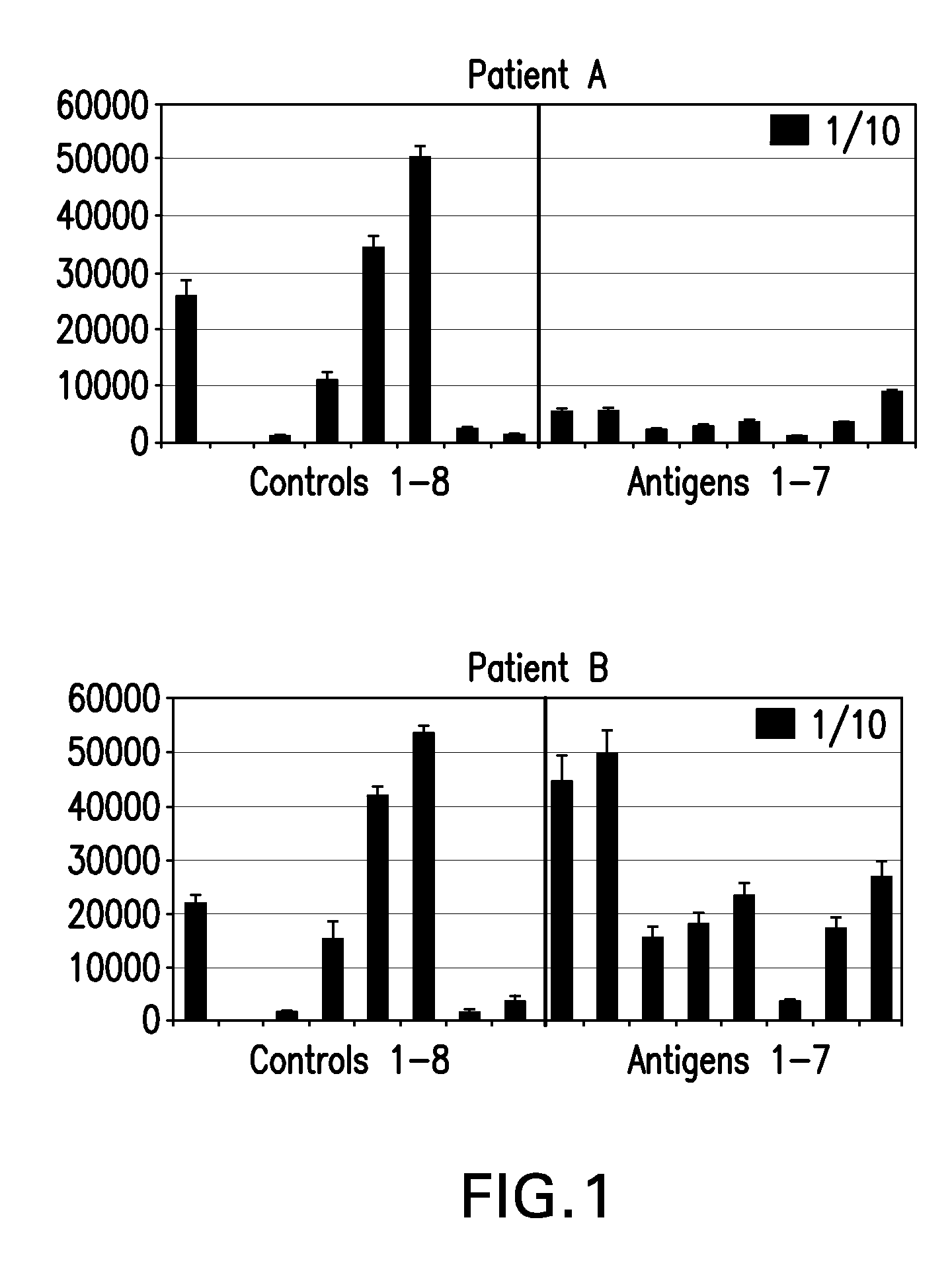Autoantibody detection systems and methods
a detection system and autoantibody technology, applied in the field of detection of autoantibodies, can solve the problems that only a few applications of autoantibodies to ct antigens have been found in diagnostics and drug development, and achieve the effect of high throughput and well-controlled multiplex assay performan
- Summary
- Abstract
- Description
- Claims
- Application Information
AI Technical Summary
Benefits of technology
Problems solved by technology
Method used
Image
Examples
example 1
Automated Assays Using Autoantibody Detection Arrays
A. Introduction
[0112]The following example addresses the problems of how to provide high content, high throughput, reliable identification of serum autoantibodies to tumor antigens through the provision of CT-antigen protein microarrays and an associated methodologies for effective assaying of human serum. Clones of full-length genes for many known CT antigens (see Table 2, above) have been obtained and expressed in insect cells. Each protein antigen is thus the product of a human gene, is full length, and has eukaryotic glycosylation by virtue of insect cell expression. Each of these factors is important in maintaining an authentic set of epitopes such recognition by serum autoantibodies is optimized. In order to assign statistical significance to candidate biomarker panels it is essential to assay as many serum samples as possible. Conventional techniques such as ELISA are limited in their throughput leading to what has been desc...
example 2
Autoantibody Detection In Melanoma Patients
[0123]Autoantibody detection arrays as described in Example 1 were used to assay serum samples from 50 patients with advanced Stage IV metastatic melanoma for antibodies to CT antigens. Patients with this disease were found to have autoantibodies to fifty CT antigens in contrast to normal healthy serum controls. Autoantibodies that were detected in the patient samples included those reactive with the following CT antigens: CTAG2, MAGEA4v2, MAGEA5, MAGEA11, NLRP4, LIP1, MAGEB6, BAGE5, MAGEB5, BAGE2, DSCR8 / MMA1, DDX53, NY-ESO-1, PBK, MICA, CXorf48.1, CT47.11, GAGE1, SSX2A, NYCO45, CSAG2, HORMAD1, ZNF165, SYCP1, GAGE5, BAGE4, SPANXD, MAGEA2, GAGE6, CEP290, NXF2, COL6A1, XAGE-2, SPANXA1, GAGE2A, SYCE1, LDHC, FTHL17, BAGE3, MAGEA4v3, MAGEB1, p53, GRWD1, MART1, MAGEA1, OIP5, CCDC33, MAGEA3, and XAGE3av2.
[0124]Results are also shown in FIG. 4, which plots relative autoantibody levels in serum versus autoantibody species for both melanoma patients ...
example 3
Autoantibody Detection In NSCLC Patients
[0125]Autoantibody detection arrays as described in Example 1 were used to assay serum samples from three patients with advanced non-small cell lung carcinoma for antibodies to CT antigens. Patients with this disease were found to have autoantibodies to numerous CT antigens in contrast to normal healthy serum controls. Autoantibodies that were detected in the patient samples included those reactive with the following CT antigens: GAGE2A, BAGE4, BAGE2, MAGEA1, DSCR8 / MMA1, CCDC33, BAGE5, CEP290, GAGE1, PBK, FTHL17, BAGE3, NLRP4, CT62, SPANXA1, DDX53, COL6A1, CSAG2, SSX2A, CT47.11, SYCP1, SPANXD, GAGE6, TSSK6, MAGEB5, ZNF165, LIP1, MICA, GAGE4, SSX4, MAGEB6, CXorf48.1, MAGEA4v2, COX6B2, MAGEA11, GRWD1, LEMD1, CTAG2, LDHC, XAGE3av2, SP011, HORMAD1, SPANXB1, TYR, MAGEB1, NYCO45, ROPN1, MAGEA5, XAGE3av1, MAGEA10, SILV, MART1, SGY-1, NXF2, MAGEA2, and RELT.
PUM
| Property | Measurement | Unit |
|---|---|---|
| diameter | aaaaa | aaaaa |
| concentrations | aaaaa | aaaaa |
| concentrations | aaaaa | aaaaa |
Abstract
Description
Claims
Application Information
 Login to View More
Login to View More - R&D
- Intellectual Property
- Life Sciences
- Materials
- Tech Scout
- Unparalleled Data Quality
- Higher Quality Content
- 60% Fewer Hallucinations
Browse by: Latest US Patents, China's latest patents, Technical Efficacy Thesaurus, Application Domain, Technology Topic, Popular Technical Reports.
© 2025 PatSnap. All rights reserved.Legal|Privacy policy|Modern Slavery Act Transparency Statement|Sitemap|About US| Contact US: help@patsnap.com



